Revista Electrónica de Investigación Educativa
Vol. 4, No. 1, 2002
Students’ Opinions Regarding the Use of Online Didactic
Support in a University Course 1
Javier Organista Sandoval
javor@uabc.edu.mx
Instituto de Investigación y Desarrollo Educativo
Universidad Autónoma de Baja California
Km. 103 Carretera Tijuana-Ensenada
Ensenada, Baja California, México
Eduardo Backhoff Escudero
backhoff@uabc.edu.mx
Instituto de Investigación y Desarrollo Educativo
Universidad Autónoma de Baja California
A.P. 453
C.P. 22830
Ensenada, Baja California, México
(Received: February 6, 2002;
accepted for publishing: April 11, 2002)
Abstract
In Mexico recently a variety of online teaching support has begun to be used for giving higher-education courses. However, little is known about students’ perceptions of this matter. The purpose of this work was to find out the opinions of the university students who took a computer-aided course that used the Internet for turning in assignments, taking exams and receiving tutorial advice. The differences of opinion were analyzed, considering socioeconomic variables, and variables of academic performance. The results indicate that the students favor the use of this kind of educational support, and that there were no important differences of opinion.
Key words: Education via Internet, online courses, students’ perceptions.
Introduction
As the use of the Internet and its technologies are becoming more popular for supporting the teaching/learning process, especially in institutions of higher education, there is coming into use a diversity of terms to refer to this new educational modality. Computer-assisted instruction, instruction and training assisted by computer, education via the Internet and virtual education are terms related to systems used to perform various activities of teaching, learning, consultation, guidance and training (Nuñez-Esquer and Sheremetov, 1999). As methods of distance education, they are characterized by the elimination of the spatial and temporal synchrony of teachers and students, in other words, face-to-face communication between the educational actors involved in education; this allows them to establish direct connections in a forum that hides ages and identities.
In general, these modalities can be used in two ways: as a means of transmitting instruction, and as didactic resources that support the teaching/learning process. In this paper, we explore the second option, meaning that online teaching aids are the computational tools used to complement instruction and reinforce learning. Among these tools are Internet discussion forums to expand what was seen in class, and Email to provide advice to the student.
The social necessity of expanding the educational offer
The great challenges in developing countries require transforming the structures of educational institutions to meet the demands for access to higher education. This is especially true for the various social groups who, for an assortment of reasons, have no access to education, or who require more flexibility (Sanchez-Soler, 1999).
To meet this challenge, the International Commission for Century XXI Education stresses the importance of open and distance education, and considers among its priorities, the use of new information and communication technologies to support educational processes, as well as the use of research for scientific and educational development (Amador-Bautista, 2000).
Consistent with these declarations, UNESCO and the ANUIES have programmed among their priority themes, open and distance learning, especially that based on the new electronic technologies of communication. For these reasons, Mexican universities recently have begun to offer a variety of online courses considering three factors: (1) population growth, (2) economic constraints and space in educational institutions and (3) the advancement of new digital technologies.
However, it is important to note that institutions of higher education may meet with unexpected difficulties in finding a demand for the virtual mode if they do not have a good understanding of the perceptions and attitudes of students towards this new educational model which, although it has great advantages, also requires certain skills and a more active participation of the learner. In this context, it is important to study the attitudes, perceptions and behaviors that students experience when taking distance-learning courses.
Given the backlog of knowledge and skills in the pedagogical use of technology as concerning the technology itself, the generation of new educational modalities has prompted several authors to take an interest in reviewing this new educational plan to determine its scope and to identify its principal problems.
Impact of computer-aided instruction on the student
In general, international research relating to the use of computer-assisted instruction has produced encouraging preliminary results: students experience significant gains in their achievement, and improve their disposition toward learning (Okolo, 1991). In particular, there have been a variety of studies to compare traditional education with distance education (Souder, 1993), to learn the styles and components of virtual learning (Schlosser and Anderson, 1994), to find out what roles the actors of the educational process should assume, (Olsen and Krendl, 1990; Inoue, 1995), and to identify the variables involved in the teaching model (Marcinkiewicz, 1993-94), among other things.
Meanwhile, national research on the use of computers for educational purposes is very recent and limited, and is carried out mainly in public universities. In a study on the current state of knowledge, Ramirez (2001) consulted the last five years of reports from memoirs of national congresses on education and computing, as well as the ARIES database of the National Autonomous University of Mexico (UNAM). He found that only 10% of the studies are concerned with distance education. At the higher-education level, he observed that the attitudes of students toward the used of computers were positive, and that almost all the reports were of a descriptive type. The author concludes that there is little empirically-validated knowledge about the use of computers, especially concerning their impact on scholastic achievement.
Interestingly enough, there is very little research exploring the perceptions of students who experience firsthand the benefits and problems of the new educational modalities. Most of the studies of distance-learning systems have focused on aspects relating to dropping out of class, dropping out of school, or students’ academic performance (Torres, 1999).
The assessment of student opinions is important, and is essential for evaluating, updating, and refining the virtual curriculum (Coussement, 1995), and for developing learning activities, so as to minimize problems and maximize the potential of this new pedagogical modality.
Purpose of the work
Because of the above mentioned information, the purpose of this study was to determine the views of students who took an undergraduate college course based on Internet technology. This article is a byproduct of a Master’s thesis entitled “Development and validation of a computerized system to manage tasks, examinations and counseling via the Internet” (Organista, 1998), in which there was developed a system using Internet technology that allowed: a) management of homework, b) administering exams and c) answering questions and providing advice to the student. The information derived from the application of that system let us validate it technically and pedagogically. The latter was done by means of the students’ opinions, which were analyzed considering some socioeconomic variables as well as the students’ academic performance.
II. Method
The original study had two methodological components: 1) The development and implementation of the system to manage assignments, tests and counseling (TEA) via the Internet. Since this has been previously described elsewhere (see Organista, 1998; Organista and Backhoff, 1999), we give here only an overview. 2) Application and validation of the TEA system in a natural educational setting. To validate the system we sought the views of students, which constitute the focus of this study.
Development of the TEA System
This computerized system was developed using Internet programming tools, and was installed on a Web server on a PC. The system includes the following modules:
• Access control, which assigns a user name and a secret password for accessing the TEA System. This module allows the user to record the date and time of access, the frequency of accesses, the total time of each one, and their origin (IP address).
• Support for the course, which includes general information, agenda, bibliography and various Internet addresses.
• Tasks, which describes and manages online assignments the student must complete during the semester, in the format which the instructor provides, limiting their delivery dates and time desired.
• Examinations, which describes and manages the five tests scheduled for the semester, available to be taken only at certain dates and times.
• Consultancy, carried out through two operating modalities: a) online counseling, through discussion forums and email; and b) the talk service of the UNIX operating system.
TEA System Application
The TEA system was used in the fall of 1997 in the course Teleprocessing Systems (eighth semester) of the Autonomous University of Baja California (UABC) School of Accounting and Administration’s BA Program in Informatics. The purpose of the course was to train students in the management of data-communication technology. It was conducted in a presencial manner, with the support of traditional audio-visual resources. However, homework, tests and advice were given in two ways: the traditional way (pencil and paper, and face to face) and via Internet (TEA system).
Students. This study involved 58 learners chosen from two groups of regular students, who were exposed to two teaching modalities: face to face, and via Internet. By the very nature of the study program, the students knew the use of the computer, but had not mastered the Internet technology.
Measurements and evaluation tools. The information in this study was obtained from two sources: socioeconomic credential, and opinion poll:
- Socioeconomic credential. Using this, we collected the following socio-economic and academic variables: gender, marital status, employment, age and scholastic achievement.
- Opinion Poll. With this instrument information was gathered on how students perceived the TEA system, and on the pedagogical and technical issues detected during its implementation. It is important to note that the original survey consisted of 24 items, of which eight were selected as more relevant for this study: five on the students’ learning process, and three on the TEA system (see Table I). The survey used a Likert scale (where 1 meant the lowest score and 6 the highest) as well as open questions.
Table I. Questions selected from the opinion poll
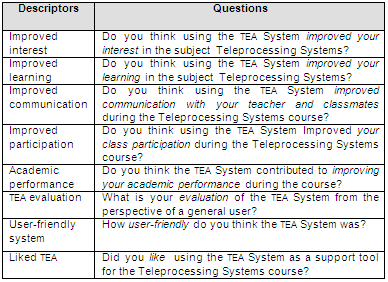
Procedure. To observe the operation of the TEA system, we chose a design in which 50% of students in the two groups alternated in the use of this system. The semester, which lasts 15 weeks, was divided into three stages (see Table II). In the first of these the traditional teaching model was followed; students’ scholastic record was obtained, and the socioeconomic credential was applied. During the second stage, half of the groups used the TEA system. At the end of this stage the opinion poll was applied to the other half of the students. During the third stage, the subgroups were alternated, and at the end of the period, the same survey was applied to the students who used the system.
Table II. Stages into which the course was divided during the study

Development of the TEA System
This computerized system was developed using Internet programming tools, and was installed on a Web server on a PC. The system includes the following modules:
• Access control, which assigns a user name and a secret password for accessing the TEA System. This module allows the user to record the date and time of access, the frequency of accesses, the total time of each one, and their origin (IP address).
• Support for the course, which includes general information, agenda, bibliography and various Internet addresses.
• Tasks, which describes and manages online assignments the student must complete during the semester, in the format which the instructor provides, limiting their delivery dates and time desired.
• Examinations, which describes and manages the five tests scheduled for the semester, available to be taken only at certain dates and times.
• Consultancy, carried out through two operating modalities: a) online counseling, through discussion forums and email; and b) the talk service of the UNIX operating system.
TEA System Application
The TEA system was used in the fall of 1997 in the course Teleprocessing Systems (eighth semester) of the Autonomous University of Baja California (UABC) School of Accounting and Administration’s BA Program in Informatics. The purpose of the course was to train students in the management of data-communication technology. It was conducted in a presencial manner, with the support of traditional audio-visual resources. However, homework, tests and advice were given in two ways: the traditional way (pencil and paper, and face to face) and via Internet (TEA system).
Students. This study involved 58 learners chosen from two groups of regular students, who were exposed to two teaching modalities: face to face, and via Internet. By the very nature of the study program, the students knew the use of the computer, but had not mastered the Internet technology.
Measurements and evaluation tools. The information in this study was obtained from two sources: socioeconomic credential, and opinion poll:
- Socioeconomic credential. Using this, we collected the following socio-economic and academic variables: gender, marital status, employment, age and scholastic achievement.
- Opinion Poll. With this instrument information was gathered on how students perceived the TEA system, and on the pedagogical and technical issues detected during its implementation. It is important to note that the original survey consisted of 24 items, of which eight were selected as more relevant for this study: five on the students’ learning process, and three on the TEA system (see Table I). The survey used a Likert scale (where 1 meant the lowest score and 6 the highest) as well as open questions.
Table I. Questions selected from the opinion poll
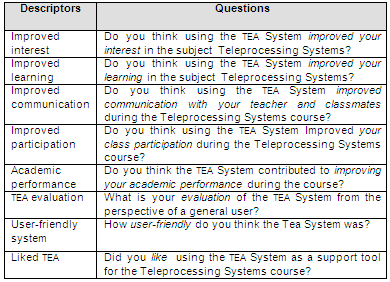
Procedure. To observe the operation of the TEA system, we chose a design in which 50% of students in the two groups alternated in the use of this system. The semester, which lasts 15 weeks, was divided into three stages (see Table II). In the first of these the traditional teaching model was followed; students’ scholastic record was obtained, and the socioeconomic credential was applied. During the second stage, half of the groups used the TEA system. At the end of this stage the opinion poll was applied to the other half of the students. During the third stage, the subgroups were alternated, and at the end of the period, the same survey was applied to the students who used the system.
Table II. Stages into which the course was divided during the study

III. Results
In the original draft for the TEA system implementation, we actually worked with four groups of students, as shown in Table II. However, for the purposes of this study it was not necessary to consider that division—which is shown for reference only—to discuss their views.
The socioeconomic characteristics of the students, taking into account the above, are shown in Table III. As we can see, of the total 58 learners, 41% were men and 59% women. Most students were single (81%). Sixty-seven percent of them were employed, while the rest devoted themselves only to school. The average age of the students was approximately 23.3 years. Finally, their academic performance, based on their average grades in high school and the university, was 8.23 and 8.59, respectively.
Table III. Characteristics of the
students surveyed
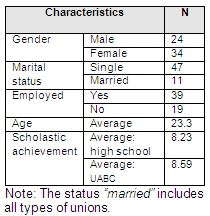
The opinions of students regarding the eight TEA-system questions (see Table I) are shown in Table IV. As we have already mentioned, the student answered each of these questions in a Likert scale, in which the value 1 represented the lowest score, and 6, the highest. This table presents the frequencies, means and standard deviations of the opinions. As we can seen, most responses are grouped in values 4, 5 and 6 of the scale, with the means varying from 4.77 to 5.65. This shows that the majority of students’ opinions were favorable toward the use of the TEA system as a means of support for doing their assignments, taking tests, and receiving advice.
Table IV. Distribution of frequencies and basic
descriptives of students’ opinions
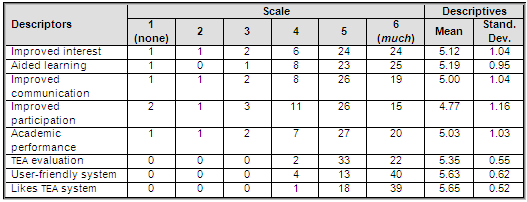
One way to know the efficiency of the system based on the opinion of students is by calculating as an indicator what we called the “relative importance” of the system. This indicator is calculated in the following manner: (a) the maximum possible value a question could obtain was calculated by multiplying the highest value of the scale (6) by the number of students who responded (58); the result (348) was equal to 100% of this indicator; (b) the score was calculated for each question, adding up the products of the scale values by their frequencies; (c) with a simple rule of three, we calculated the relative importance of the question.
Figure 1 presents the results of this analysis. Here you can see that the relative importance of the questions ranged roughly between 80% and 94%. The higher opinions tell us that the students liked using the TEA system as a support for the instruction they received. Furthermore, the system was user-friendly in its operation, favored the learning of the course and improved student interest.
As for the lower opinions, they show that the weakest aspect of this modality lies in students’ classroom participation and communication; although it was not necessarily bad, that was where the system helped least.
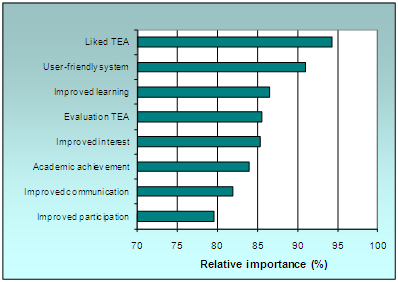
Fig. 1. Relative importance of students’ opinions
regarding use of the TEA
To know whether the opinion of the students varied according to their personal characteristics, an analysis of variance was made using the One way ANOVA and Levene’s tests to compare the homogeneity of variances, with the statistical package SPSS (v.10.0). Table V shows the means of the responses of students grouped by gender, marital status, employment status, age and achievement. It is important to note that for the case of age and achievement, the subgroups were formed considering the medians of these variables. Thus, students in the “high” group were those who were above the median; and the “low” group, those who were below this parameter.
Table V. Means of students’ opinions according to their personal characteristics
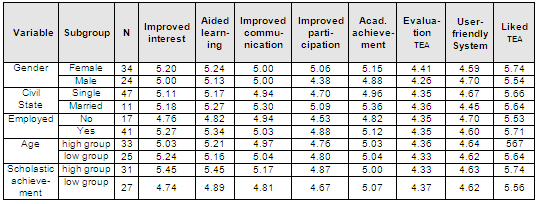
Tables VI and VII show the results of analyzing variance and homogeneity.
As we can see in Table VI, of the 40 comparisons made, very few were significant (p <0.05). Additionally, if we take into account that their variances were not always homogeneous, as shown in Table VII, we can say that we have found only two significant differences in students’ opinion: (1) students of lower scholastic achievement perceived an improvement in their learning and (2) women perceived that the system improved their class participation. These results imply that the opinion of students is quite uniform regarding the use of the TEA system in a university course.
Table VI. Results of the ANOVA (F) test for each variable
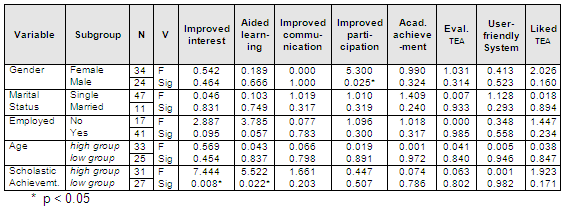
Table VII. Test results of Levene’s homogeneity of variances
(F-Lev) test for each variable
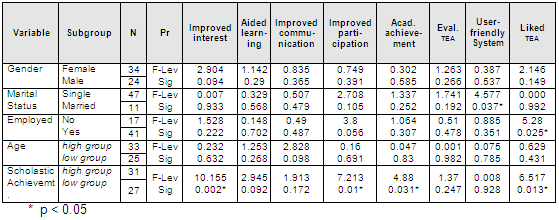
Finally, so that we could understand the problems faced by students when using the Internet system, we asked them in the survey to specify the most important aspects that, in their opinion, should be improved. Table VIII shows a summary of student responses on problems encountered, and suggestions for solving them
It is interesting to see hat the issues raised are technical and not pedagogical, a most encouraging aspect from the pedagogical standpoint. However, we must recognize that an essential part of the success of distance education is the efficient operation of the equipment and communication system.
Table VIII. Description of the types of problems and suggestions
related with the use of the TEA System
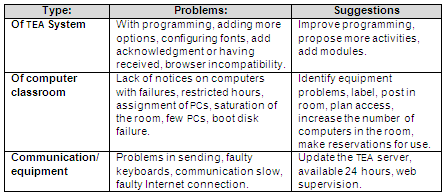
IV. Discussion
In general, the results confirm that the use of new digital technologies to support teaching/learning process are well received by students in higher education.
The opinion of college students after using a computerized system to manage tasks, testing and consulting services, favors the incorporation of this modality into their regular courses. In particular, students perceived that their interest was improved by the course, and that it encouraged learning. The least-favored aspects were class participation and interpersonal communication. In this regard, we should note that one might expect that the inclusion of the computer as a nerve center for academic liaison would alter the type of interaction occurring in a classroom where traditionally the model of communication has been face to face. Therefore, an educational challenge for computer-assisted learning is to improve the interaction between teacher, machine and student.
On the other hand, it is interesting to note that there are virtually no significant differences in the opinions of students related with the following variables: gender, age, marital status and scholastic achievement. Few significant differences were observed in low-performance students who perceived that the TEA system increased their interest in the course and improved their learning. In the case of the gender variable, the significant difference recorded has to do with the perception of women regarding the improvement of their class participation; contrary to the findings by Olsen and Krendl (1990) who commented in their study that those of the feminine gender maintained somewhat skeptical attitudes toward the use of technology, and that this did not change with time.
Finally, we must say that the results presented here must be tempered by the fact that students who participated in this research were studying informatics, so it would be expected that they would have a positive attitude toward what was related to new communication technologies. An opinion concurring with the above was expressed by Waern and Ramberg (1996), who noted that students’ prior knowledge and computing experience are factors that significantly influence their perceptions concerning incorporating the computer into the educational process
In conclusion, in the students’ opinion, the incorporation of new communication technologies in the classroom is a real alternative that helps break down barriers imposed by space and time on the teaching/learning process. However, it is important to take into account that to optimize the educational process, we must know the problems students face regarding these media, both technical and pedagogical. On the latter will depend whether the use of computers will be an alternative as a support tool for Mexican education. Finally, it is considered urgent and necessary to promote well-designed research projects that will give answers to the many questions which remain unanswered. As examples, we mention the following: (1) differences of opinion of students with diverse personal and academic characteristics (e.g. educational level, age, vocational interests, etc.) and (2) student satisfaction regarding various components of the teaching/learning process (e.g. time spent, activities, interaction with the teacher, counseling received, etc.)
References
Amador-Bautista, R. (2000, junio). Redes de telecomunicaciones para la integración de redes de investigación. Paper presented at Primer Congreso de Educación a Distancia 2000, Ensenada, BC
Coussement, S. H. (1995). Educational telecommunication: Does it work? Tuscaloosa, AL: University of Alabama. (ERIC Reproduction Service No. ED 391 465).
Inoue, Y. (1995). Determinants of the use of computer-assisted instruction at a university in Singapore. Memphis, TN: University of Memphis. (ERIC Reproduction Service No. ED 391 470).
Marcinkiewicz, H. R. (1993-94). Computers and teachers: Factors influencing computer use in the classroom. Journal of Research on Computing in Education, 26 (2), 220-237.
Núñez-Esquer, G. & Sheremetov, L. (1999). Ambiente computacional de enseñanza-aprendizaje cooperativo personalizado. Revista de la Educación Superior, 28 (110), 63-82.
Okolo, C. M. (1991). Learning and behaviorally handicapped students’ perceptions of instructional and motivational features of computer assisted instruction. Journal of Research on Computing in Education, 24 (2), 171-188.
Olsen, B. & Krendl, K. A. (1990). At-risk students and microcomputers: What do we know and how do we know it? Journal of Educational Technology Systems, 19 (2), 165-175.
Organista, J. (1998). Desarrollo y validación de un sistema computarizado para administrar tareas, exámenes y asesorías vía Internet. Unpublished master’s thesis, Universidad Autónoma de Baja California, Ensenada, B.C., México.
Organista, J. & Backhoff, E. (1999). El uso de Internet para administrar tareas, exámenes y asesorías en la educación superior. Revista de la Educación Superior, 28 (112), 57-74.
Ramírez-Romero, J. L. (2001). Educación y computación: una aproximación al estado actual de su investigación en México. Revista Mexicana de Investigación Educativa, 6 (11), 119-137.
Sánchez-Soler, M. D. (1999). La educación a distancia en México y propuestas para su desarrollo. Revista de la Educación Superior, 28 (110), 59-82.
Schlosser, C. A. & Anderson, M. L. (1994). Distance education: A review of the literature. Ames, IA: Research Institute for Studies in Education, Iowa State University. (ERIC Reproduction Service No ED382159).
Souder, W. E. (1993). The effectiveness of traditional vs. satellite delivery in three management of technology master’s degree programs. The American Journal of Distance Education, 7 (1), 37-53.
Torres, V. A. (1999). La competencia en el uso de las nuevas tecnologías de información y comunicación en los sistemas de educación superior abiertas y a distancia. Paper presented at V Congreso Nacional de Investigación Educativa, Aguascalientes, Ags.
Waern, Y. & Ramberg, R. (1996). People’s perception of human and computer advice. Computers in Human Behavior, 12 (1), 17-27.
Translator: Lessie Evona York Weatherman
UABC Mexicali
1Extended version of a paper presented at the 1st Congress of Open and Distance Education 2000 (Ensenada, BC, June 8-10, 2000) entitled “The use of Internet in the teaching/learning process: higher-education students’ opinions”.
Please cite the source as:
Organista, J. & Backhoff, E. (2002). Students’ opinions regarding the use of online didactic support in a university course. Revista Electrónica de Investigación Educativa, 4 (1). Retrieved month day, year from: http://redie.ens.uabc.mx/vol4no1/contents-organista.html









